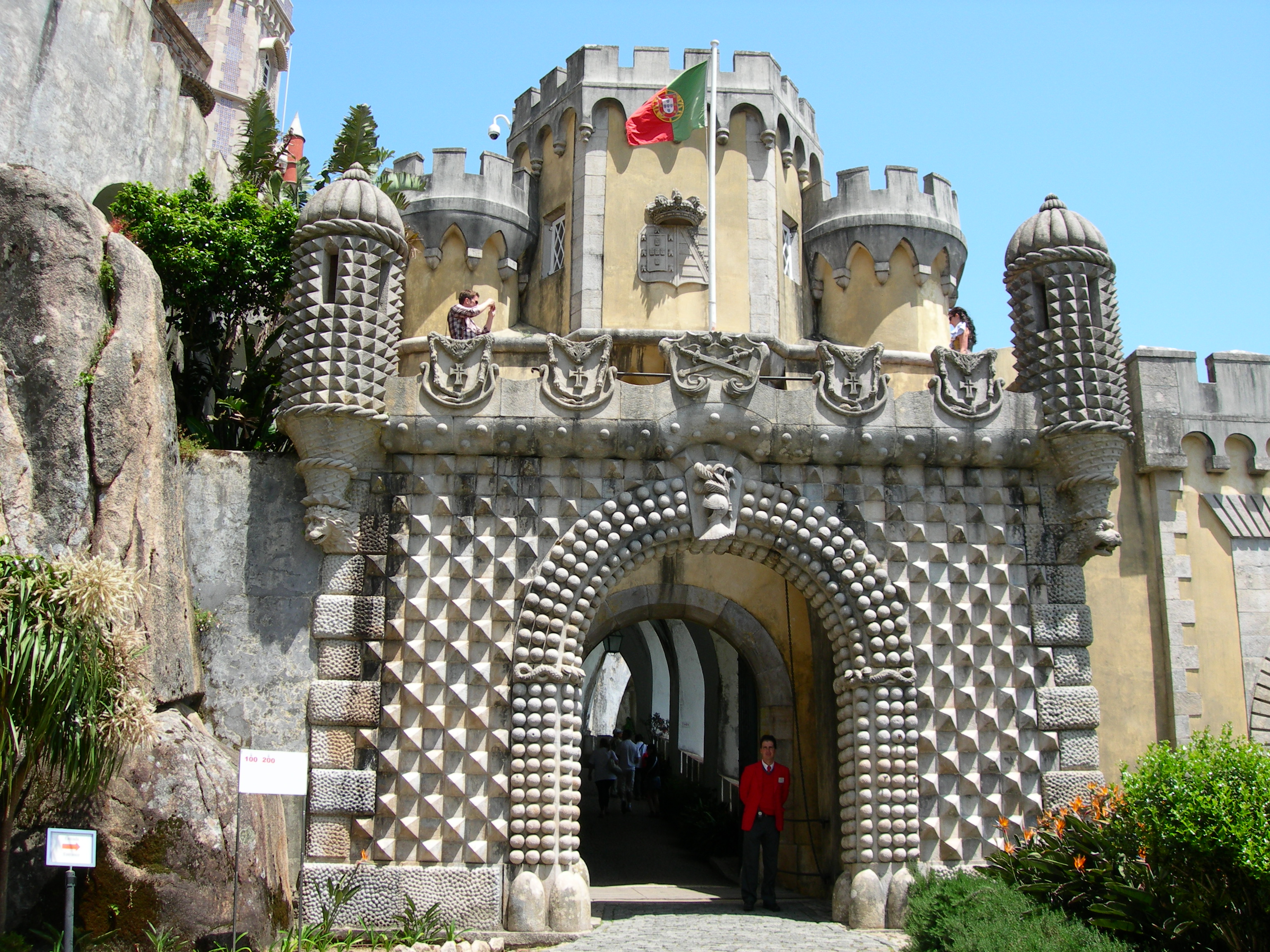Palácio Nacional da Pena

 O Palácio da Pena
O Palácio da Pena
O Palácio da Pena ergue-se sobre uma rocha escarpada, que é o segundo ponto mais alto da Serra de Sintra (acima do palácio só se encontra a Cruz Alta, a 528m de altitude). O Palácio localiza-se na zona oriental do Parque da Pena, que é necessário percorrer para se chegar à íngreme rampa que o Barão de Eschwege construiu para se aceder à edificação acastelada. O Palácio propriamente dito é constituído por duas alas: o antigo convento manuelino da Ordem de São Jerónimo e a ala edificada no século XIX por D. Fernando II. Estas alas estão rodeadas por uma terceira estrutura arquitetónica, em que se fantasia um imaginário castelo de caminhos de ronda com merlões e ameias, torres de vigia, um túnel de acesso e até uma ponte levadiça.
Em 1838 o rei D. Fernando II adquiriu o antigo convento de monges Jerónimos de Nossa Senhora da Pena, que tinha sido erguido no topo da Serra de Sintra em 1511 pelo rei D. Manuel I e se encontrava devoluto desde 1834 com a extinção das ordens religiosas. O convento compunha-se do claustro e dependências, da capela, sacristia e torre sineira, que constituem hoje o núcleo norte do Palácio da Pena, ou Palácio Velho.
D. Fernando começou por efetuar reparações no antigo convento, que, segundo fontes da época, se encontrava em muito mau estado. Remodelou todo o piso superior, substituindo as catorze celas por salas de maiores dimensões e cobrindo-as com as abóbadas que hoje vemos. Cerca de 1843, o rei decidiu ampliar o Palácio através de uma nova ala (Palácio Novo) com salas de ainda maior dimensão, de que é exemplo o Salão Nobre, rematando-a com um torreão circular junto às novas cozinhas. A obra foi dirigida pelo Barão de Eschwege.
No restauro de 1994 repuseram-se as cores originais no exterior do Palácio: rosa-velho para o antigo mosteiro, ocre para o Palácio Novo.
Ao transformar um antigo mosteiro numa residência acastelada, D. Fernando revelou ter uma forte influência do romantismo alemão, tendo-se provavelmente inspirado nos castelos à beira do Reno de Stolzenfels e Rheinstein, assim como na residência de Babelsberg em Potsdam. A obra do Palácio da Pena terminou em meados da década de 1860, embora posteriormente se fizessem campanhas de decoração de interiores.
D. Fernando mandou igualmente plantar o Parque da Pena nas áreas envolventes do Palácio à maneira dos jardins românticos, com caminhos serpenteantes, pavilhões e bancos de pedra a pontuar os percursos, bem como árvores e outras plantas provenientes dos quatro cantos do mundo, tirando partido do clima húmido da serra de Sintra e criando de raiz um parque exótico com mais de quinhentas espécies arbóreas.
A construção mais interessante do Parque da Pena é o Chalet da Condessa (ou Casa do Regalo), que se encontra no extremo ocidental do Parque da Pena. Foi mandado construir por D. Fernando II e pela sua futura segunda mulher, Elise Hensler (Condessa d’Edla), como local de veraneio reservado. É uma construção de dois pisos com forte carga cénica, de inspiração alpina, que mantinha uma expressiva relação visual com o Palácio.
O Palácio da Pena foi classificado como Monumento Nacional em 1910 e integra-se na Paisagem Cultural de Sintra, classificada pela UNESCO como Património Mundial da Humanidade desde 1995.
Em 2013 passou a integrar a Rede de Residências Reais Europeias.

Chalet da Condessa / Chalet of the Countess of Edla
 The Palace of Pena
The Palace of Pena
The Palace of Pena stands atop a rocky peak, which is the second highest point in the Sintra hills (the only place higher than the palace itself is the Cruz Alta, 528 metres above sea level). The palace is situated in the eastern part of the Park of Pena, which one has to pass through to reach the steep ramp built by the Baron of Eschwege that provides access to the castle-like building. The palace itself is composed of two wings: the former Manueline monastery of the Order of St. Jerome and the wing built in the 19th century by King Ferdinand II. These wings are ringed by a third architectural structure that is a fantasised version of an imaginary castle, whose walls one can walk around and which comprises battlements, watchtowers, an entrance tunnel and even a drawbridge.
In 1838, King Ferdinand II acquired the former Hieronymite monastery of Our Lady of Pena, which had been built by King Manuel I in 1511 on the top of the hill above Sintra and had been left unoccupied since 1834 when the religious orders were suppressed in Portugal. The monastery consisted of the cloister and its outbuildings, the chapel, the sacristy and the bell tower, which today form the northern section of the Palace of Pena, or the Old Palace as it is known.
King Ferdinand began by making repairs to the former monastery, which, according to the historical sources of that time, was in very bad condition. He refurbished the whole of the upper floor, replacing the fourteen cells used by the monks with larger-sized rooms and covering them with the vaulted ceilings that can still be seen today. In roughly 1843, the king decided to enlarge the palace by building a new wing (the New Palace) with even larger rooms (the Great Hall is a good example of this), ending in a circular tower next to the new kitchens. The building work was directed by the Baron of Eschwege.
The 1994 repair works restored the original colours of the Palace’s exterior: pink for the former monastery and ochre for the New Palace.
In transforming a former monastery into a castle-like residence, King Ferdinand showed that he was heavily influenced by German romanticism, and that he probably found his inspiration in the Stolzenfels and Rheinstein castles on the banks of the Rhine, as well as Babelsberg Palace in Potsdam. These building works at the Palace of Pena ended in the mid-1860s, although further work was also undertaken at later dates for the decoration of the interiors.
King Ferdinand also ordered the Park of Pena to be planted in the Palace’s surrounding areas in the style of the romantic gardens of that time, with winding paths, pavilions and stone benches placed at different points along its routes, as well as trees and other plants originating from the four corners of the earth. In this way, the king took advantage of the mild and damp climate of the Sintra hills to create an entirely new and exotic park with over five hundred different species of trees.
The most fascinating construction in the Park of Pena is the Chalet of the Countess of Edla, also known as the House of Indulgence (Casa do Regalo), which is located at the park’s western end. Its building was commissioned by King Ferdinand II and his future second wife, Elise Hensler (the Countess of Edla), as a private summer residence. It is a two-storey building with a very scenic appearance, denoting a distinctive alpine inspiration and maintaining an expressive visual relationship with the Palace.
The Palace of Pena was designated a National Monument in 1910 and forms part of the Cultural Landscape of Sintra, which has been classified by UNESCO as World Heritage since 1995.
In 2013, the Palace was integrated into the Network of European Royal Residences.

O Portão de Ferro / The Iron Gate
 A cache
A cache
 A entrada no Parque da Pena está sujeita ao pagamento de taxas de acesso.
A entrada no Parque da Pena está sujeita ao pagamento de taxas de acesso.
Para registar a geocache não é obrigatória a entrada no Palácio. Porém, a geocache já se situa dentro do Parque da Pena, cuja entrada está sujeita ao pagamento de uma taxa de acesso e a um horário. Esta taxa varia conforme a época do ano, existindo descontos de idade, descontos de grupo, desconto de Happy Hour ou ainda descontos para munícipes de Sintra. Por estarem constantemente em alteração, por favor, consulte qual o preçário e o horário atuais na página oficial (desça até encontrar "Parque e Palácio Nacional da Pena") do Parque e Palácio da Pena.
Para validar o registo desta geocache tem de se deslocar até as coordenadas iniciais, onde irá encontrar o acesso principal ao Palácio. O acesso é feito através do Portão de Ferro. Aqui terá de:
- Tirar uma foto de si (não sendo obrigatório que o seu rosto seja visível) ou ao seu dispositivo GPS, com o Portão de Ferro e a bandeira portuguesa como fundo.
- Para além disto, irá ter que tomar nota da data inscrita por cima do Portão de Ferro (ver foto acima!) que deverão traduzir para numeração árabe (exemplo: MMXVII -> 2017).
Terá de me enviar a foto (que também pode incluir no seu registo) e o ano, em numeração árabe, pelo Centro de Mensagens ou, se preferir, por e-mail, certificando-se que envia o seu e-mail juntamente com a mensagem. Pode, após o envio, registar a geocache. Caso exista alguma inconformidade, entrarei em contacto consigo. Todos os registos que não respeitem estas regras serão eliminados. Boas cachadas!
 The cache
The cache
 The access to Pena Park is subject to a payment of access fees.
The access to Pena Park is subject to a payment of access fees.
To log this geocache you do not have to enter the Palace. However, the geocache is located inside the Pena Park, whose entry is subject to a fee and a timetable. This fee varies in regard to the time of the year. There are age, group and Happy Hours discounts.Because they are constatly changing, please check the current ticket price and timetable on Park and National Palace of Pena's official website (scroll down to Park and National Palace of Pena).
To validate your log on this geocache you have to visit the posted coordinates, where you'll find the main entrance to the Palace. The main access is through The Iron Gate. Here you'll have to:
- Take a picture of yourself (your face does not have to be visible) or your GPS unit, with The Iron Gate and the portuguese flag in the background.
- You'll also have to take note of the date written above the Iron Gate (see picture above!), which you have to translate to arabic numerals(example: MMXVII -> 2017).
You'll need to send me the picture (which you can also post on your log) and the date, in arabic numerals, through The Message Center or,if you like it the most, e-mail, making sure your send your e-mail adress along with the message. You are now allowed to log the geocache. If there're any problems I'll get in contact with you. All logs that do not respect these rules will be deleted. Happy caching!


 Virtual Reward - 2017/2018
Virtual Reward - 2017/2018
Esta Cache Virtual faz parte de uma série limitada de Virtuais criadas entre 24 de Agosto de 2017 e 24 de Agosto de 2018. Apenas 4000 proprietários de geocaches receberam a oportunidade de esconder uma Virtual. Saiba mais no Geocaching Blog.
 Virtual Reward - 2017/2018
Virtual Reward - 2017/2018
This Virtual Cache is part of a limited release of Virtuals created between August 24, 2017 and August 24, 2018. Only 4,000 cache owners were given the opportunity to hide a Virtual Cache. Learn more about Virtual Rewards on the Geocaching Blog.